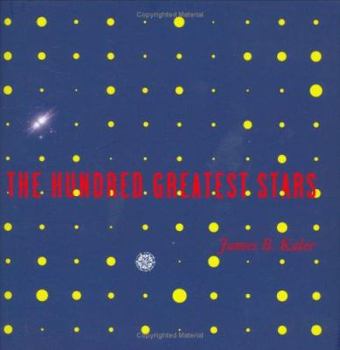The Hundred Greatest Stars
Select Format
Select Condition 
Book Overview
While there are guides to the visible sky, this is the first book to encompass the most important stars known in the universe at a level accessible to the layperson. The noted astronomer James Kaler takes us on a tour of the 100 most interesting stars, describing their characteristics and importance in words and vivid pictures.
Format:Hardcover
Language:English
ISBN:0387954368
ISBN13:9780387954363
Release Date:June 2002
Publisher:Copernicus Books
Length:211 Pages
Weight:1.90 lbs.
Dimensions:0.9" x 8.3" x 8.2"
Customer Reviews
4 ratings
A Little Gem
Published by Thriftbooks.com User , 18 years ago
Jim Kaler has written a real little gem in this book. It selects 100 of the most interesting stars and gives a "biography" of each. His style is engaging and readable. The author seems to have intended the audience to be amateur astronomers, but I have found it quite useful for students in both secondary school and the university. I have always told my students that "stars are like people, if you examine them closely, all of them are strange in some way", and this book highlights some of the more interesting ones. Along the way, a fair bit of astronomical information is also imparted, but in a way that flows naturally with the stories. The book has good production quality. This is a fairly short book, very approachable for students who might be science shy. I think this is the best one that Jim has done so far. My only quibble is that he left out RU Cam, which should have been given a place in this collection.
The Hundred Greatest Stars by Kaler
Published by Thriftbooks.com User , 20 years ago
This book has spectacular views of major stars/ clusters.The 3 brightest stars of the Southern Hemisphere are depicted.These stars are Sirius, Canopus and Alpha Centauri.Important scientific rule structures are explained. i.e.The apparent magnitude of a star is a function of distance.In addition, Absolute Magnitude and Color are proportional totemperature. Important statistics are provided for stars: i.e. Blue-White Stars have 32-50 illumination with Ionized Helium.Infrared stars are 1000 degrees with prominent methane bands.Stars with > 10 solar masses--are exploding stars<br> <p>Ag Dra has powerful eruptions. Celestial Harp is approximately<br>880 Light Years with a 2600 times the sun luminosity.<p>This work is a virtual treasure-chest of scientific facts and<br>data about stars. It is perfect for a school science project.<br>The book is written for a large constituency of readers. i.e.<br>Astronomers, scientists, general audiences, teachers,<br>museum administrators and many others.
Informative and colorful
Published by Thriftbooks.com User , 20 years ago
No Katharine Hepburn or Al Pacino here. Instead we have Betelgeuse and Cygnus X-1, Deneb and MXB 1730-335 and 96 other illuminators of the night sky as selected by University of Illinois at Urbana-Champaign Professor of Astronomy James B. Kaler. They are called "the greatest" mostly because they are significant in one way or another and partly because they are Kaler's favorites.Of course included are Alpha Centauri, our closest interstellar neighbors, and Barnard's Star, the fastest moving star across our line of sight, and Polaris, the North Star, friend to navigators. The sun is included for comparison and reference. Kaler begins the book with what he calls an "Introduction and Allegro" in which he explains what stars are and how they are classified and how they evolve. Then come mini essays on the each of the chosen stars, what's interesting and important about them, their history and vital statistics beginning with number zero, the sun. He identifies the "Residence" of each star according to astronomical constellation, alternative name, its class such as F2 giant (Beta Cassiopeiae), its visual magnitude, its distance from us, its absolute visual magnitude, and its "Significance" (e.g., ESO 439-26 is "The faintest known white dwarf.") Because of the range of different types of stars that Kaler has chosen (with wildly differing system configurations), double and triple stars, stars with known planets, pulsars, neutron stars, black holes, etc., reading through the various essays amounts to a modest astronomical education in itself.There are color plates pertaining to each star, sometimes of the star and sometimes of the area of the sky in which the star can be found, and sometimes pertaining to something significant about the star such as a colorful drawing of the inflowing gas from the giant surrounding the black hole at Cygnus X-1.There's a modest glossary and three appendices, one listing the stars by their various names for easy recognition, the second by their evolutionary status (Main Sequence stars, Neutron stars, etc.), and the third by position (by Declination and Right Association). This works well as an introduction to stars and their nature and as a source of reference for the amateur star-gazer. It is an attractive book that would make a fine gift especially for a young person just becoming interested in astronomy. It is technical in spots, but overall it is readily accessible to the general reader.
Informative, superbly illustrated, astronomical reference
Published by Thriftbooks.com User , 21 years ago
Accessibly written by James B. Kaler (Professor of Astronomy, University of Illinois - Urbana-Champaign), The Hundred Greatest Stars is an incredible, informative, superbly illustrated, astronomical reference describing one hundred different stars ranging from Acrux to ZZ Ceti. Each individual star has a full color photograph and an accompanying page of scientific description with close attention to detail. The Hundred Greatest Stars is a strongly recommended, beautifully illustrated study for astronomy buffs.




